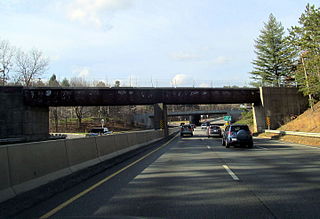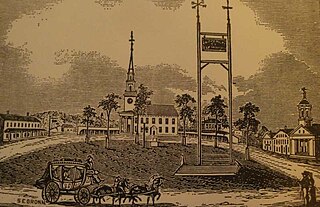
Boxborough is a town in Middlesex County, Massachusetts, United States. The population was 4,996 at the 2010 census. The town name is often simplified to "Boxboro" on highway signs and official documents.

Nashua is a city in southern New Hampshire, United States. As of the 2010 census, it had a population of 86,494, the second-largest in northern New England after nearby Manchester. As of 2019 the population had risen to an estimated 89,355. Along with Manchester, it is a seat of New Hampshire's most populous county, Hillsborough.
The Massachusetts Turnpike is a toll highway in the U.S. state of Massachusetts that is maintained by the Massachusetts Department of Transportation (MassDOT). The turnpike begins at the New York state line in West Stockbridge, linking with the Berkshire Connector portion of the New York State Thruway. Spanning 138 miles (222 km) along an east–west axis, it is entirely concurrent with the portion of Interstate 90 (I-90) that lies within the state. The turnpike is the longest Interstate Highway in Massachusetts, while I-90 in full is the longest Interstate Highway in the United States.
U.S. Route 3 (US 3) is a United States highway running 277.9 miles (447.2 km) from Boston, Massachusetts, through New Hampshire, to the Canada–US border near Third Connecticut Lake, where it connects to Quebec Route 257.

Greater Boston is the metropolitan region of New England encompassing the municipality of Boston, the capital of the U.S. state of Massachusetts and the most populous city in New England, as well as its surrounding areas. The region forms the northern arc of the US northeast megalopolis and as such, Greater Boston can be described either as a metropolitan statistical area (MSA), or as a broader combined statistical area (CSA). The MSA consists of most of the eastern third of Massachusetts, excluding the South Coast region and Cape Cod; while the CSA additionally includes the municipalities of Providence, Rhode Island, Manchester, Worcester, Massachusetts, as well as the South Coast region and Cape Cod in Massachusetts. While the small footprint of the city of Boston itself only contains an estimated 685,094, the urbanization has extended well into surrounding areas; the CSA is one of two in Massachusetts, the only other being Greater Springfield. Greater Boston is the only CSA-form statistical area in New England which crosses into three states.
Route 2 is a 142.29-mile-long (228.99 km) major east–west state highway in Massachusetts. Along with Route 9 and U.S. Route 20 to the south, these highways are the main alternatives to the Massachusetts Turnpike/I-90 toll highway. Route 2 runs the entire length of the northern tier of Massachusetts, beginning at the New York border, where it connects with New York State Route 2, and ending near Boston Common in Boston. Most of the route is a freeway through central Massachusetts, with the longest non-freeway portions being the western and eastern ends. Portions of Route 2 follow the Mohawk Trail, while older alignments are known as Route 2A.

The Middlesex Canal was a 27-mile (44-kilometer) barge canal connecting the Merrimack River with the port of Boston. When operational it was 30 feet wide, and 3 feet deep, with 20 locks, each 80 feet long and between 10 and 11 feet wide. It also had eight aqueducts.

Levi Lincoln Jr. was an American lawyer and politician from Worcester, Massachusetts. He was the 13th Governor of Massachusetts (1825–1834) and represented the state in the U.S. Congress (1834–1841). Lincoln's nine-year tenure as governor is the longest consecutive service in state history; only Michael Dukakis, John Hancock and Caleb Strong served more years, but they were not consecutive.

Massachusetts Avenue is a major thoroughfare in Boston, Massachusetts, and several cities and towns northwest of Boston. According to Boston magazine, "Its 16 miles of blacktop run from gritty industrial zones to verdant suburbia, passing gentrified brownstones, college campuses and bustling commercial strips."
The Frederick E. Everett Turnpike, also called the Central New Hampshire Turnpike, is a toll road in the U.S. state of New Hampshire, running 44 miles (71 km) from the Massachusetts border at Nashua north to Concord. The Everett Turnpike is named for Frederick Elwin Everett, the first Commissioner of the New Hampshire Department of Transportation.
Route 111 is a 27.282-mile-long (43.906 km) state highway in Massachusetts, a continuation of New Hampshire Route 111. The route has a north–south component and an east–west one, though it is signed exclusively as a north–south route on newer signs. The east–west portion of the route largely follows the path of the Union Turnpike, built in the early 19th century to connect the communities of Leominster and Concord.
Route 225 is a state highway in the U.S. state of Massachusetts. The highway runs 31.100 miles (50.051 km) from Route 2A in Lunenburg in northeastern Worcester County east to Route 2 in Lexington. Route 225 serves the western Middlesex County towns of Shirley, Groton, Westford, and Carlisle. The highway also passes through Bedford along its concurrency with Route 4, which terminates at the same junction with Route 2.

The Cambridge and Concord Turnpike was an early turnpike between Cambridge and Concord, Massachusetts. Portions have been incorporated into today's Massachusetts Route 2; the remainder forms other major local roads.

The Middlesex Turnpike was an early turnpike between Cambridge and Tyngsborough, Massachusetts and the New Hampshire border, where it connected with the Amherst Turnpike and thence Nashua and Claremont, New Hampshire.
The Heart of New England Council is a Boy Scouts of America council serving Cub Scout packs, Scouts BSA troops, Exploring posts and Venturing crews in central Massachusetts with administrative support, program resources, activities, events, and camping properties.

The Montachusett Regional Transit Authority (MART) is a public, nonprofit organization established under Chapter 161B of the Massachusetts General Laws to provide public transportation to the Montachusett Region. MART is one of Massachusetts' 15 regional transit authorities and provides public transportation to 21 communities within the Montachusett region consisting of the cities of Fitchburg, Leominster and Gardner, and the towns of Athol, Ashburnham, Ashby, Ayer, Bolton, Boxborough, Hardwick, Harvard, Hubbardston, Lancaster, Littleton, Lunenburg, Royalston, Shirley, Sterling, Stow, Templeton, Westminster, and Winchendon.
The Fifth Massachusetts Turnpike was one of over 60 toll roads in operation throughout Massachusetts in the first half of the 19th century. An act establishing the Corporation was approved by the Massachusetts legislature on March 1, 1799. The Preamble to the act reads:

The Fitchburg and Worcester Railroad was a railroad in Massachusetts. It was incorporated in 1840 to provide a rail connection between Fitchburg and Worcester. Service began on February 11, 1850, running 18 miles from Fitchburg through Leominster and Sterling to Sterling Junction, where it connected with the Worcester and Nashua Railroad.

Beacon Park Yard was a CSX Transportation rail yard in Allston, Boston, now owned by Harvard University. The yard opened in 1890 on the site of a former trotting park, from which it took its name. It was closed in 2013 following the relocation of the yard's container operations to Worcester, Massachusetts and opening of a transload facility in Westborough, Massachusetts. Plans for the yard include relocation of the Massachusetts Turnpike Allston exit, construction of a new MBTA commuter rail station and layover yard, and a major real estate development.

The Barre Turnpike was one of over 60 toll roads in operation throughout Massachusetts in the first half of the 19th century. As described in the Act of Incorporation, February 5, 1822, the road ran
from the Common, near the meeting house in Barre; thence easterly, in the best course to Hubbardston line thence through the southerly part of Hubbardston, in the best direction to Princeton line; thence, in the best course, through part of Princeton, and through the land of David Rice; and thence through land of Jason Woodward, to a road crossing a town road, and to a road leading to Edward Goodenow's.














